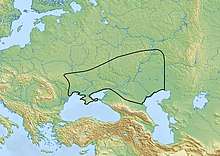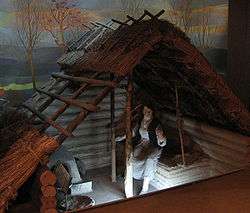Srubnaya culture
The Srubnaya culture (Russian: Сру́бная культу́ра, romanized: Srubnaya kultura, lit. 'log house culture'), also known as Timber-grave culture, was a Late Bronze Age (18th–12th centuries BC) culture[1] in the eastern part of Pontic-Caspian steppe. It is a successor of the Yamna culture, Catacomb culture and Poltavka culture. It is co-ordinate and probably closely related to the Andronovo culture, its eastern neighbor.[1] Whether the Srubnaya culture originated in the east, west, or was a local development, is disputed among archaeologists.[1]
 | |
| Geographical range | Pontic steppe |
|---|---|
| Period | Bronze Age |
| Dates | ca. 1800–1200 BC |
| Preceded by | Catacomb culture |
| Followed by | Belozerskaya culture, Bondarikhinskaya culture |
| Part of a series on |
| Indo-European topics |
|---|
 |
|
|
Philology
|
|
Origins |
|
Archaeology Pontic Steppe
Caucasus East Asia Eastern Europe Northern Europe Pontic Steppe Northern/Eastern Steppe Europe
South Asia Steppe Europe Caucasus India |
|
Peoples and societies Indo-Aryans Iranians
East Asia Europe East Asia Europe
Indo-Aryan Iranian
|
|
Religion and mythology
Indo-Aryan Iranian Others Europe
|
|
The name comes from Russian сруб (srub), "timber framework", from the way graves were constructed. Animal parts were buried with the body.
Distribution
The Srubnaya culture occupied the area along and above the north shore of the Black Sea from the Dnieper eastwards along the northern base of the Caucasus to the area abutting the north shore of the Caspian Sea, west of the Ural Mountains.[1] Historical testimony indicate that the Srubnaya culture was succeeded by the Cimmerians and Scythians.[1]
Characteristics
The Srubnaya culture is named for its use of timber constructions within its burial pits. Its cemeteries consisted of five to ten kurgans. Burials included the skulls and forelegs of animals and ritual hearths. Stone cists were occasionally employed.[1] Srubnaya settlements consisted of semi-subterranean and two-roomed houses. The presence of bronze sickles, grinding stones, domestic cattle, sheep and pigs indicate that the Srubnaya engaged in both agriculture and stockbreeding.[1]
Language
The Srubnaya culture is generally considered to have been Iranian. It has been suggested as a staging area from which the Iranian peoples migrated across the Caucasus into the Iranian Plateau.[1]
Physical type
Physical remains of Srubnaya people have has revealed that they were massively built Europoids with largely dolichocephalic skulls. Skulls from the early (Pokrovskiy) phase of Srubnaya are purely dolichocephalic, and very similar to those of the earlier Fatyanovo–Balanovo culture, Abashevo culture and Sintashta culture, and the western areas of the contemporary Andronovo culture. They differ from the less dolichocephalic skulls of the Potapovka culture.
With the expansion of the Srubnaya culture onto the southern steppe, Srubnaya skulls become less dolichocephalic, probably through the absorption of elements from the earlier Yamnaya culture and Poltavka culture. In later phases however, dolichocephaly increases again among the Srubnaya. The physical type of the Srubnaya is very similar to that of the succeeding Scythians, suggesting that the Scythians were largely descended from the Srubnaya.
Genetics

In a study published on 10 October 2015,[2] 14 individuals of the Srubnaya culture could be surveyed. Extractions from 100% of the males (six men from 5 different cemeteries) were determined to be of Y-chromosome haplogroup R1a1. Extractions of mtDNA from fourteen individuals were determined to represent five samples of haplogroup H, four samples of haplogroup U5, two samples of T1, one sample of T2, one sample of K1b, one of J2b and one of I1a.
A 2017 genetic study published in Scientific Reports found that the Scythians shared similar mitochondrial lineages with the Srubnaya culture. The authors of the study suggested that the Srubnaya culture was ancestral to the Scythians.[3]
In 2018, a genetic study of the earlier Srubnaya culture, and later peoples of the Scythian cultures, including the Cimmerians, Scythians, Sarmatians, was published in Science Advances. Six males from two sites ascribed to the Srubnaya culture were analysed, and were all found to possess haplogroup R1a1a1. Cimmerian, Sarmatian and Scythian males were however found have mostly haplogroup R1b1a1a2, although one Sarmatian male carried haplogroup R1a1a1. The authors of the study suggested that rather than being ancestral to the Scythians, the Srubnaya shared with them a common origin from the earlier Yamnaya culture.[4]
In a genetic study published in Science in 2018, the remains of twelve individuals ascribed to the Srubnaya culture was analyzed. Of the six samples of Y-DNA extracted, three belonged to R1a1a1b2 or subclades of it, one belonged to R1, one belonged to R1a1, and one belonged to R1a1a. With regards to mtDNA, five samples belonged to subclades of U, five belonged to subclades of H, and two belonged to subclades of T. People of the Srubnaya culture were found to be closely related to people of the Corded Ware culture, the Sintashta culture, Potapovka culture and the Andronovo culture.[lower-alpha 1][lower-alpha 2] These were found to harbor mixed ancestry from the Yamnaya culture and peoples of the Central European Middle Neolithic.[5] The genetic data suggested that these cultures were ultimately derived of a remigration of Central European peoples with steppe ancestry back into the steppe.[lower-alpha 3]
Notes
- "We observed a main cluster of Sintashta individuals that was similar to Srubnaya, Potapovka, and Andronovo in being well modeled as a mixture of Yamnaya-related and Anatolian Neolithic (European agriculturalist-related) ancestry."[5]
- "Genetic analysis indicates that the individuals in our study classified as falling within the Andronovo complex are genetically similar to the main clusters of Potapovka, Sintashta, and Srubnaya in being well modeled as a mixture of Yamnaya-related and early European agriculturalist-related or Anatolian agriculturalist-related ancestry."[5]
- "Corded Ware, Srubnaya, Petrovka, Sintashta and Andronovo complexes, all of which harbored a mixture of Steppe_EMBA ancestry and ancestry from European Middle Neolithic agriculturalists (Europe_MN). This is consistent with previous findings showing that following westward movement of eastern European populations and mixture with local European agriculturalists, there was an eastward reflux back beyond the Urals."[5]
References
- Mallory & Adams 1997, pp. 541–542
- Mathieson 2015.
- Juras, Anna (March 7, 2017). "Diverse origin of mitochondrial lineages in Iron Age Black Sea Scythians". Nature Communications. 7: 43950. doi:10.1038/srep43950. PMC 5339713. PMID 28266657.CS1 maint: ref=harv (link)
- Krzewińska, Maja (October 3, 2018). "Ancient genomes suggest the eastern Pontic-Caspian steppe as the source of western Iron Age nomads". Nature Communications. 4 (10): eaat4457. doi:10.1126/sciadv.aat4457. PMC 6223350. PMID 30417088.CS1 maint: ref=harv (link)
- Narasimhan 2019.
Bibliography
- Kuzmina, Elena E. (2007). Mallory, J. P. (ed.). The Origin of the Indo-Iranians. BRILL. ISBN 978-9004160545.CS1 maint: ref=harv (link)
- Mallory, J. P.; Adams, Douglas Q. (1997). "Srubna Culture". Encyclopedia of Indo-European Culture. Taylor & Francis. pp. 541–542. ISBN 1884964982.CS1 maint: ref=harv (link)
- Mathieson, Iain (November 23, 2015). "Genome-wide patterns of selection in 230 ancient Eurasians". Nature. Nature Research. 528 (7583): 499–503. doi:10.1038/nature16152. PMC 4918750. PMID 26595274.CS1 maint: ref=harv (link)
- Narasimhan, Vagheesh M. (September 6, 2019). "The formation of human populations in South and Central Asia". Science. American Association for the Advancement of Science. 365 (6457): eaat7487. bioRxiv 10.1101/292581. doi:10.1126/science.aat7487. PMC 6822619. PMID 31488661.CS1 maint: ref=harv (link)
External links
